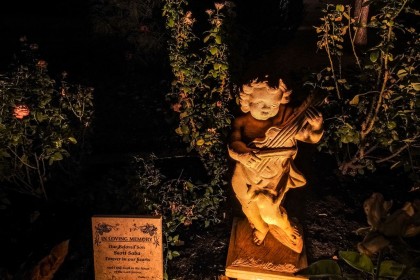
At North Star Outdoor Lighting, we believe that the right lighting can transform any space, turning it from ordinary to extraordinary. Imagine your garden sculptures and water features coming alive at night, bathed in light that highlights their beauty and showcases their intricate details. The transformative power of outdoor lighting is unparalleled, bringing a magical ambiance to your outdoor spaces and making your art installations and water features the centerpieces they deserve to be.
In this blog, we aim to provide you with comprehensive guidance on how to light your outdoor sculptures and water features effectively. Whether you have a majestic statue, a serene fountain, or a dynamic waterfall, the right lighting techniques can enhance their beauty and impact, creating a captivating visual experience. We will explore various lighting techniques, positioning strategies, and types of lights that can bring out the best in your outdoor art.
Proper lighting is crucial for outdoor art and water features because it not only enhances their aesthetic appeal but also ensures they can be enjoyed at any time of day or night. Without appropriate lighting, even the most stunning sculptures and water features can fade into the darkness, losing their charm and visual interest once the sun sets. Effective lighting highlights the textures, shapes, and movements of your art, adding depth and drama to your outdoor space.
At North Star Outdoor Lighting, we understand the art and science of lighting design. Our expertise in creating tailored lighting solutions can help you achieve the perfect illumination for your outdoor art installations. Join us as we delve into the world of outdoor art lighting and discover how to make your sculptures and water features truly shine.
Understanding the Basics of Outdoor Art Lighting
Types of Outdoor Art
Outdoor art encompasses a variety of installations, each with unique lighting needs. Sculptures are often abstract or representational and can range from small garden pieces to large monumental works used as focal points in gardens and public spaces. Water features, including fountains, ponds, and waterfalls, introduce a dynamic element to outdoor spaces with the interplay of light and moving water creating captivating visual effects. Each type requires a tailored approach to lighting to enhance its aesthetic and functional qualities, ensuring that every curve, angle, and flow is beautifully highlighted.
Key Lighting Principles
Several fundamental principles guide the effective lighting of outdoor art. Focal points are crucial; they draw attention to the most important aspects of the piece. Balance ensures that the lighting does not overpower the artwork but complements it, maintaining visual harmony. Contrast is essential for creating depth and interest, making sure that light and shadow work together to reveal the art’s textures and shapes. Shadow play, the art of using shadows to add dimension, can make sculptures and water features appear more dynamic and intriguing. Understanding these principles helps in planning a lighting scheme that enhances rather than detracts from the beauty of outdoor art.
Positioning Lights for Maximum Impact
Strategic Placement
Strategic light placement is key to highlighting the most important features of outdoor art. Proper positioning can transform an artwork, making it a striking feature in any landscape. Up-lighting involves placing lights at the base of the sculpture or water feature, casting light upwards. This technique is ideal for tall sculptures and trees, creating dramatic and imposing visuals. Down-lighting, where lights are placed above the artwork and directed downwards, mimics natural moonlight and is excellent for broad, soft coverage that highlights the entire piece. Cross-lighting involves using lights from multiple angles to eliminate harsh shadows and add depth, ensuring that every detail of the art is visible.
Angles and Distances
The angles and distances at which lights are placed can significantly affect the final appearance. For instance, placing lights too close to the artwork can create harsh, unflattering shadows, while positioning them too far can result in insufficient illumination. The ideal angle often depends on the specific features of the artwork. A general rule is to experiment with different positions and distances to find the perfect balance that enhances the piece’s details and overall impact. Adjusting angles can help in achieving the desired effects, such as highlighting specific textures or creating intriguing shadow patterns.
Types of Lights to Use
LED Lights
LED lights are a popular choice for outdoor art lighting due to their energy efficiency and long lifespan. They are available in various colors and intensities, allowing for flexibility in creating different moods and effects. LEDs consume less power compared to traditional lighting options, making them an environmentally friendly choice. They also generate less heat, which is beneficial for delicate art installations.
Solar Lights
Solar lights are an eco-friendly option that harnesses the power of the sun to illuminate outdoor art. They are easy to install and require minimal maintenance. However, their effectiveness depends on the amount of sunlight they receive, which can be a limitation in shaded areas or during overcast weather. Despite this, solar lights are a cost-effective and sustainable choice for many outdoor lighting needs.
Halogen Lights
Halogen lights produce a bright, white light that can make outdoor art stand out. They are often used for their superior brightness and clarity. However, they consume more energy and generate more heat than LEDs, making them less efficient. Despite their drawbacks, halogen lights are a good option for situations where intense, focused light is required.
Fiber Optic Lights
Fiber optic lights are ideal for precise illumination without generating heat, making them perfect for delicate installations. They can be used to highlight specific details of a sculpture or water feature, providing a soft, ambient glow. Fiber optic lights are versatile and can be used creatively to achieve unique lighting effects.
Lighting Techniques for Sculptures
Highlighting Details
Using focused beams to highlight specific details or textures of a sculpture can make the artwork more visually appealing. This technique involves directing narrow beams of light onto particular areas to draw attention to intricate features.
Silhouetting
Positioning lights behind a sculpture to create a striking silhouette can add drama and intrigue to the piece. This technique works well for sculptures with distinctive shapes and outlines, creating a bold visual impact.
Shadowing
Placing lights to cast interesting and dramatic shadows on surrounding surfaces can enhance the sculpture’s presence. Shadowing adds depth and dimension, making the artwork appear more dynamic.
Color Accents
Utilizing colored lights can enhance the mood or theme of a sculpture. Different colors can evoke various emotions and create different atmospheres, adding another layer of meaning to the artwork.
Lighting Techniques for Water Features
Submersible Lights
Submersible lights are ideal for illuminating water from within, making them perfect for fountains and ponds. These lights create a mesmerizing effect by highlighting the movement and flow of water.
Underwater Spotlights
Underwater spotlights can be used to highlight specific areas of a water feature, such as a waterfall or bubbling stream. They add depth and interest by drawing attention to particular elements.
Surface Lighting
Using lights above the water surface to create reflections and sparkle can enhance the beauty of water features. Surface lighting adds a magical quality to the water, making it appear more vibrant and lively.
Motion and Flow
Incorporating lighting that emphasizes the movement of water, such as ripples and waves, can create dynamic visual effects. This technique enhances the natural beauty of water features by highlighting their fluidity and motion.
Creating Dramatic Effects
Dynamic Lighting
Introducing movement and variation with programmable lights that change color or intensity can create a dynamic visual experience. Dynamic lighting keeps the display interesting and engaging, as it constantly evolves.
Layered Lighting
Combining multiple types of lighting to add depth and dimension can make outdoor art more visually complex and intriguing. Layered lighting involves using different lighting techniques and fixtures to create a multifaceted effect.
Theatrical Techniques
Borrowing techniques from stage lighting, such as using gels and gobos, can create unique effects for outdoor art. These techniques allow for creative expression and can transform a simple lighting scheme into a theatrical display.
Practical Considerations
Weather Resistance
Ensuring all lighting fixtures are weatherproof and durable is essential for outdoor installations. Weather-resistant lights are designed to withstand the elements, ensuring longevity and reliability.
Energy Efficiency
Choosing energy-efficient lighting options can reduce costs and environmental impact. Energy-efficient lights consume less power, leading to lower electricity bills and a smaller carbon footprint.
Safety
Considering safety aspects, such as wiring and fixture placement, is crucial to avoid tripping hazards or electrical issues. Proper installation and maintenance ensure that the lighting system is safe for everyday use.
Maintenance and Longevity
Regular Cleaning
Keeping lights and fixtures clean is essential to maintain brightness and clarity. Regular cleaning removes dirt and debris that can diminish the effectiveness of the lights.
Inspection and Replacement
Regularly inspecting and replacing any damaged or worn-out components is necessary to ensure the lighting system functions properly. Timely replacements prevent issues and maintain the overall quality of the display.
Upgrades and Adjustments
Staying updated with new lighting technologies and adjusting installations as needed can enhance the effectiveness and appeal of outdoor art lighting. Upgrades can introduce new features and improve the overall performance of the lighting system.
Illuminate Your Outdoor Art with North Star Outdoor Lighting
In this blog, we’ve explored the transformative power of outdoor lighting on art installations and water features, highlighting how proper illumination can enhance their beauty and impact. We discussed various types of outdoor art, including sculptures, statues, and water features, and introduced key lighting principles such as focal points, balance, contrast, and shadow play. We delved into strategic light placement techniques like up-lighting, down-lighting, and cross-lighting, and provided guidance on the best angles and distances to achieve the desired effects.
We also covered the types of lights to use, from energy-efficient LEDs and eco-friendly solar lights to bright halogen lights and precise fiber optic lights. Specific lighting techniques for sculptures included highlighting details, silhouetting, shadowing, and using color accents, while water features benefited from submersible lights, underwater spotlights, surface lighting, and lighting that emphasizes motion and flow. Additionally, we touched on creating dramatic effects with dynamic lighting, layered lighting, and theatrical techniques.
Practical considerations such as weather resistance, energy efficiency, and safety were discussed, along with maintenance tips to ensure the longevity and effectiveness of your outdoor lighting. Regular cleaning, inspection, and upgrading of lighting systems are essential to keep your outdoor art looking its best.
We encourage you to experiment with different lighting techniques to find what works best for your unique outdoor art installations. The right lighting can significantly enhance the visual appeal and emotional impact of your sculptures and water features, making your outdoor space a stunning visual experience.
For those seeking professional assistance, North Star Outdoor Lighting is here to help. Our expertise in custom lighting solutions ensures that your outdoor art will be showcased in the best possible light. Contact us today to discover how we can illuminate your outdoor art and transform your landscape into a captivating masterpiece.
















